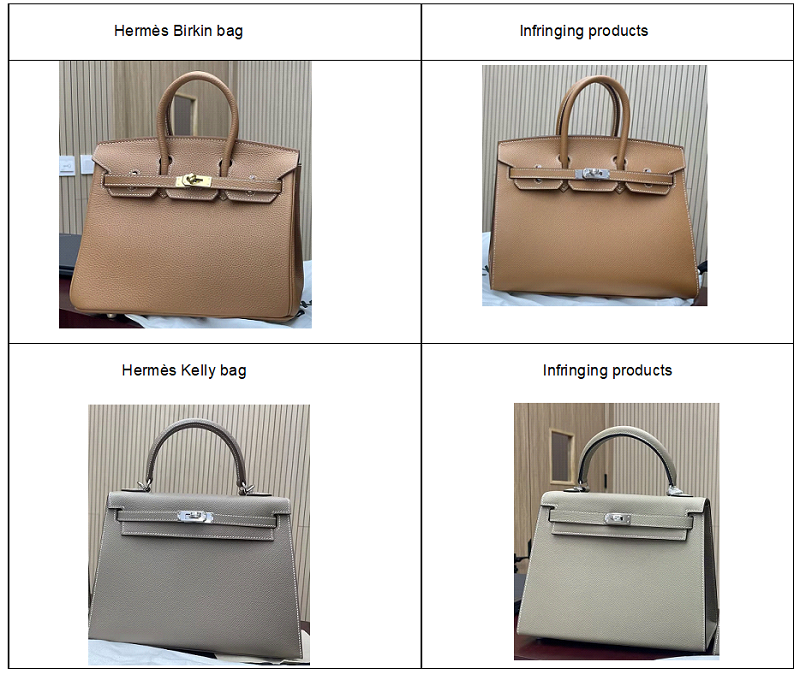Design of Hermès’ iconic Birkin and Kelly bags held to constitute “trade dress with a certain influence”
He Wei and Wen Cui, 25 November 2024, first published by WTR
• Hermès sued the defendants for selling HXXXXS-branded handbags, the designs of which were strikingly similar to Hermès’ Kelly and Birkin bags
• The court found that the shapes of the Kelly and Birkin bags constituted “trade dress with certain influence” under the Anti-unfair Competition Law
• The decision offers an alternative route for luxury brand owners
Background
Hermès is a prestigious French luxury fashion house founded in 1937, with ladies’ handbags being one of the best-selling products of the company. The trade dress of the Kelly and Birkin handbags, as the representative designs in the industry, are widely loved by consumers.
Hermès found out that Guangzhou Tongmei Brand Management Co Ltd and Guangzhou Youge Brand Management Co Ltd jointly promoted and sold online HXXXXS-branded handbags, the designs of which were strikingly similar to Hermès’ Kelly and Birkin handbags. The two entities also used Hermès’ trademarks BIRKIN, KELLY, CONSTANCE, PICOTIN, H and LINDY on their official websites, online stores and product labels to promote the infringing products.

Court proceedings
Hermès sued the two companies before the Yuhang District Court of Hangzhou, requesting that the court ascertain the following:
1. The design of Hermès’ iconic Kelly and Birkin handbags constitutes “trade dress with certain influence”, as stipulated by Article 6 of the Anti-unfair Competition Law.
2. The defendants used, without permission, designs similar to those of Hermès’ handbags, which constituted an act of unfair competition.
3. The defendants’ use of Hermès’ marks constituted trademark infringement.
Hermès requested the cessation of such acts, damages of Rmb3 million and reimbursement of its litigation costs, among other things.
The defendants' submitted the following argument in their defence:
1. Trademark infringement: the contested marks BIRKIN, KELLY, CONSTANCE, PICOTIN, H and LINDY were not used as trademarks. In addition, the use of their proprietary trademark HXXXXS clearly indicated the source of the bags. As a result, the consumers would not be confused as to the source of the bags.
2. Unfair competition: the trade dress of the Birkin and Kelly bags could not function as a source identifier of the products. In particular, the CNIPA’s refusal of 3D trademark applications for the shape of these bags clearly affirmed the non-distinctiveness of the claimed trade dress. In addition, Hermès had a unique business model and the Kelly and Birkin bags were much more expensive than the defendants’ bags, so that consumers would not be confused as to the source of the bags.
First and second-instance decisions
On 29 April 2024 the Yuhang District Court rendered the following judgment:
1. The defendants used the contested marks on their website and Tmall store, and on the tags of the bags in a clear and prominent manner, which constituted trademark use. The unauthorised use of Hermès’ trademarks on identical products constituted trademark infringement.
2. The trade dress of the Kelly and Birkin handbags has a certain level of distinctiveness. The bags enjoy a high reputation and influence, having established a stable one-to-one correspondence with Hermès. Therefore, the shapes of the Kelly and Birkin bags constituted “trade dress with certain influence” under the Anti-unfair Competition Law. As the defendants’ bags utilised trade dress that was visually almost identical to the claimed trade dress, such use was likely to cause confusion among the relevant public. Therefore, unfair competition had been established.
The court thus ordered the cessation of such use and awarded Hermès damages of Rmb2.3 million. The defendants appealed before the Hangzhou Intermediate Court, which upheld the first-instance decision on 13 September 2024.
Comment
Luxury brands have fallen victims to the prevalent imitation of their unique product shape and/or designs in the Chinese market. As it is extremely difficult to secure 3D trademark registrations in China, brand owners cannot resort to the Trademark Law to stop the infringement of their product shape and/or designs. This case offers an alternative route, as brand owners may turn to the Anti-unfair Competition Law and seek trade dress protection instead.
The second-instance decision is the first effective decision by which a Chinese court has granted protection to the shape of a handbag on the basis of the Anti-unfair Competition Law. It may serve as a point of reference for similar cases in the future.
This article first appeared in WTR Daily, part of World Trademark Review, in November 2024. For further information, please go to www.worldtrademarkreview.com.



